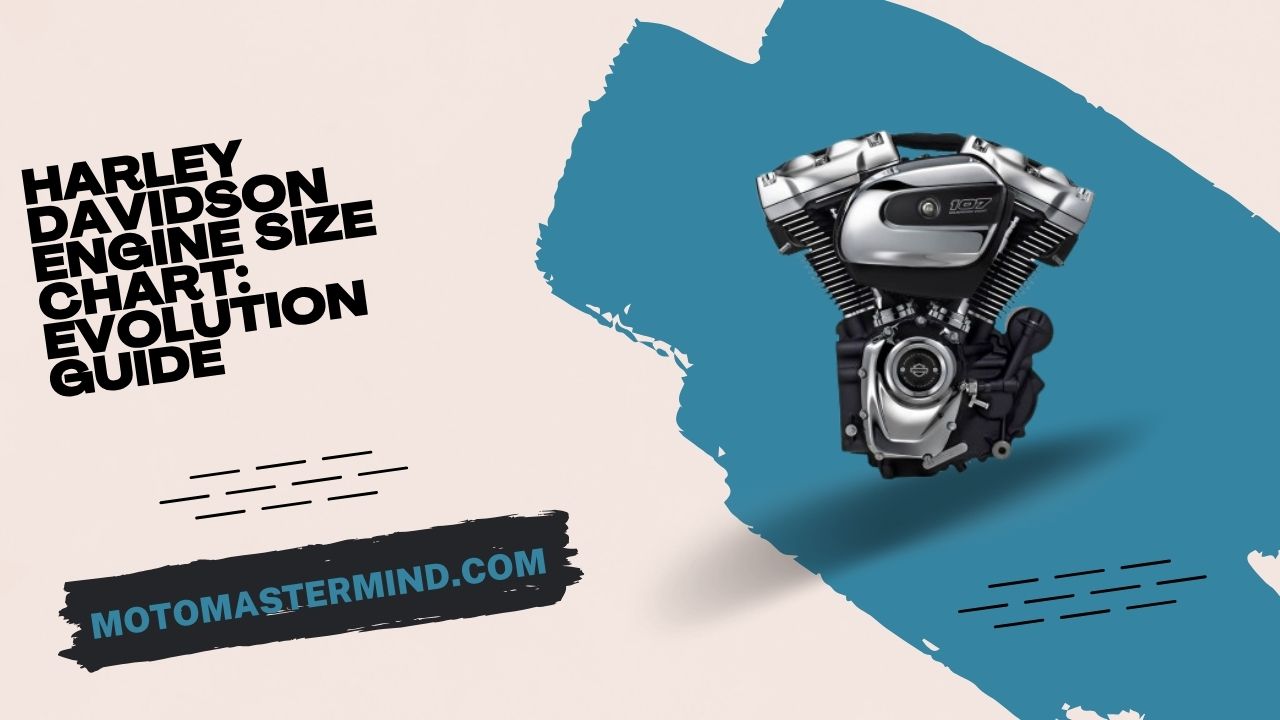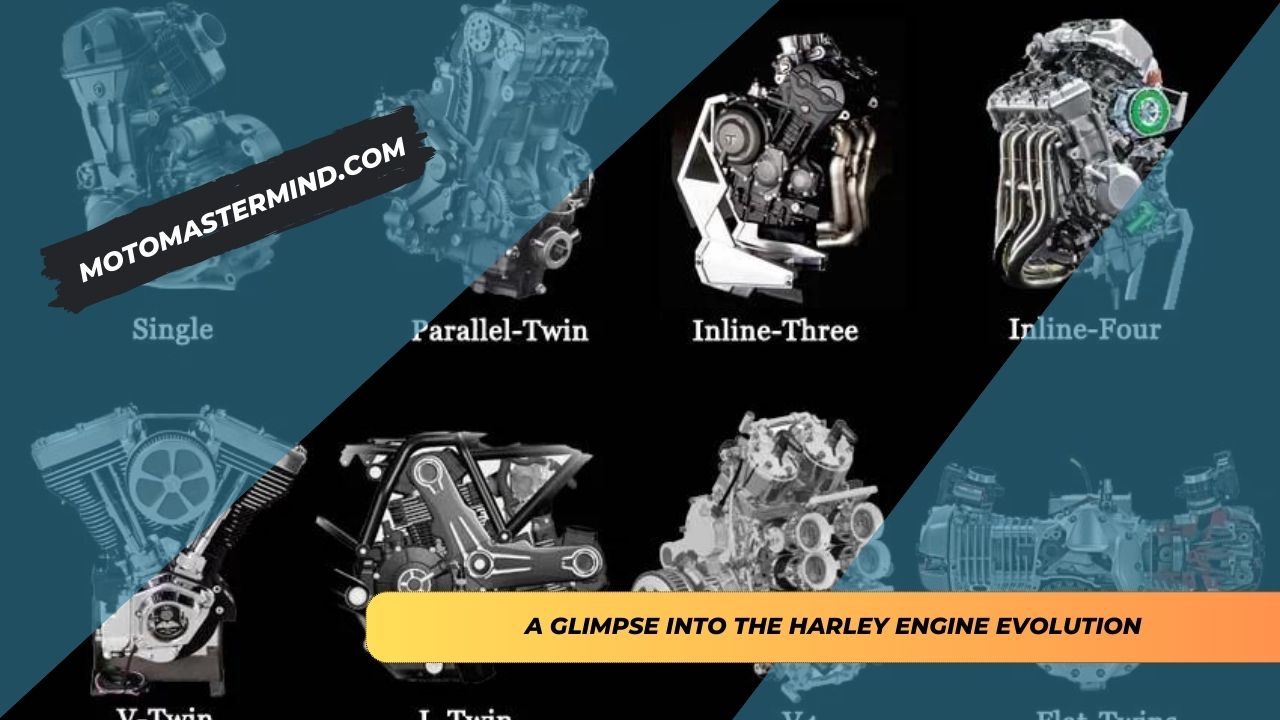
The deep growl of a Harley-Davidson motorbike is legendary, and its epicenter lies in its very core: the engine.
Yet, every Harley engine tells a different story. Through the years, Harley-Davidson has crafted machines of varied dimensions and features.
For enthusiasts, old and new, this guide aims to offer an in-depth look at the Harley-Davidson engine size chart.
Harley Davidson Engine Size Chart
| Engine Name | Volume (CI) | Volume (CC) |
|---|---|---|
| F-Head | 61ci & 74ci | 1000cc & 1210cc |
| Flathead | 45ci & 74ci | 737cc & 1212cc |
| Knucklehead | 61ci & 74ci | 983cc & 1212cc |
| Panhead | 61ci & 74ci | 983cc & 1200cc |
| Shovelhead | 74ci & 80ci | 1212cc & 1343cc |
| Evolution (Big Twin) | 80ci | 1343cc |
| Evolution (Sportster / Small V-Twin) | 54ci & 73ci | 883cc & 1200cc |
| V-Rod (Revolution) | 76ci | 1247cc |
| Twin Cam 88 & Twin Cam 88B | 88ci | 1442cc |
| Twin Cam 95 | 95ci | 1550cc |
| Twin Cam 96 | 96ci | 1584cc |
| Twin Cam 103 | 103ci | 1690cc |
| Twin Cam 110 | 110ci | 1800cc |
| Milwaukee Eight 107 (Standard) & 107 | 107ci | 1746cc |
| Milwaukee Eight 114 | 114ci | 1868cc |
| Milwaukee Eight 117 | 117ci | 1923cc |
A Glimpse into the Harley Engine Evolution

The Distinct 45° F-Head V-Twin
The 45° F-Head V-Twin engine often resonates when considering a classic Harley rumble. This engine is a powerhouse symbolizing the American motorcycle industry’s rise in the early 1900s.
- Historical Insights: Faced with intense rivalry, particularly from brands like India, Harley refined their engine designs.
- Key Design Elements: Termed as the “IOE” or “inlet over the exhaust,” the F-Head’s peculiar valve setup had its intake valve atop and the exhaust valve to the side. This combined the advantages of both overhead and side-valve designs. The 45° V-Twin design gave the engine its signature compactness and distinct exhaust rhythm. Initially, it boasted a 61 cubic-inch displacement, striking a balance between torque, power, and efficiency. This engine was pivotal in cementing Harley-Davidson’s status as a top motorcycle producer.
- Legacy and Impact: Its performance, unique “potato-potato” sound, and reliability marked the 45° F-Head V-Twin as a game-changer, reinforcing Harley’s stature as motorcycling transitioned from a luxury hobby to a practical transport method. Though later overshadowed by newer engines, its impact on Harley’s history remains undiminished.
The Revered Flathead V-Twin
Another name that sparks admiration among motorcycle enthusiasts is the Harley-Davidson Flathead V-Twin. A pillar in the Evolution of American motorcycling, it further underscored Harley’s dominance.
- Background Overview: Launched in the 1920s, the Flathead, characterized by its flat-topped, side-valve cylinder heads, reigned supreme for over 30 years, attesting to its enduring popularity.
- Notable Features: The simplicity of its side-valve design, though less potent than overhead valve systems, was its hallmark. Its robustness ensured longevity, even with extended use. Like other iconic Harley engines, the V-Twin design stood out, giving the brand its iconic sound and feel.,
- Model Variations: The Flathead was produced in sizes from 45 to 74 cubic inches over its lifespan. One of its most notable deployments was in the WLA during WWII. Its basic design also became a canvas for custom modifications.
The Iconic Knucklehead
Though not official, “Knucklehead” stems from the engine’s unique look, reminiscent of knuckles on a clenched fist.
- Historical Backdrop: The 1930s, marred by the Great Depression, saw a slump in motorcycle sales. As the economy rebounded, there was a clamor for more potent, technologically superior bikes. Enter the Knucklehead.
- Technological Strides: The Knucklehead marked Harley’s shift to the OHV engine, a leap from traditional flathead designs. It introduced a revamped oil system, replacing the older “total-loss” oiling mechanism.
- Model Introduction: The first in line were the E and EL models. The E boasted a 61 cubic inch engine, while the EL presented a beefier 74 cubic inch engine.
- Popularity and Legacy: From its inception, the Knucklehead became a favorite, offering riders an unparalleled blend of power, aesthetics, and dependability. Today, it’s a sought-after gem for collectors. Even though its production ceased in 1947, making way for the Panhead engine, its imprint on Harley-Davidson’s chronicles and the motorcycle domain is profound.
Dive deeper, explore more, and let the Harley Davidson Engine Size Chart be your guide through the ages of motorcycling mastery.
Panhead’s Reign: 1948-1965
Emerging in 1948, the Panhead took over from its predecessor, the Knucklehead, dominating since 1936. Its name was inspired by its pan-like rocker covers
Key Features:
- Introducing hydraulic valve lifters is a significant move to reduce the frequent valve adjustments needed in its predecessor.
Sizes Offered:
- Sixty-one cubic inches (1,000cc) labeled the EL model.
- Seventy-four cubic inches (1,200cc), termed the FL model.
Major Update: 1965, the Panhead received an electric start, transitioning into the Electra Glide.
Panhead’s Cultural Footprint
The Panhead didn’t merely serve as a machine. In the 1950s post-war boom, it symbolized American motorcycling’s golden era. The Panhead gained recognition through movies like “The Wild One,” which showcased outlaw bikers on Panhead-like motorcycles. This solidified the bad-boy biker image.
Legacy Lives On
Though its production ceased in 1965, making way for the Shovelhead, the Panhead’s legacy remains unfazed. Vintage Panhead bikes and custom builds with their engines remain sought-after collectibles.
Shovelhead’s Time: An Answer to Power and Speed
Marked by its shovel-like valve covers, the Shovelhead aimed to provide an upgraded alternative to the Panhead. Harley Davidson sought an engine that resonated with a growing demand for increased power and speed.
Notable Characteristics:
- Starting at 74 cubic inches (1208 cc), it expanded to 80 cubic inches (1340 cc) in its later years.
- Revamped aluminum heads for better airflow, power, and cooling.
- Incorporation of the Panhead’s single camshaft design, but with reinforced components.
- Initially, the “Dry-sump” oil system was used; however, circulation issues led to subsequent modifications.
- In 1970, a shift from a 6-volt to a 12-volt electrical system.
Shovelhead’s Resonance
The Shovelhead era is nostalgically celebrated, symbolizing Harley’s core spirit and tradition. Its signature auditory and tactile experience remains a hallmark of American motorcycling.
The Rise of Evolution
Harley-Davidson was compelled to innovate when it faced stiff competition from Japanese makers in the late 1970s and early 1980s. This led to the advent of the Evolution engine in 1984, succeeding the Shovelhead. It beautifully blended Harley’s traditional aesthetics with modern engineering.
Crucial Improvements:
- Aluminum for cylinder heads: Lighter with superior cooling.
- Enhanced reliability with tight tolerances and quality materials.
- Better oil circulation, alleviating previous overheating issues.
The Impact of Evolution
The Evolution engine wasn’t just a technical masterpiece. It revitalized Harley-Davidson’s identity in the competitive 80s and 90s landscape. Many enthusiasts credit the Evolution engine for keeping Harley-Davidson afloat amidst fierce competition.
Evolution’s Enduring Legacy
The Twin Cam 88 took over from the Evolution engine in 1999, but the Evolution’s influence on the motorcycle world remains unparalleled.
The Twin Cam 88 Era
It was introduced to bring a fresh touch while preserving Harley’s unique charm. It took over from the Evolution, which was revolutionary in its own right.
Engine Characteristics:
- Dual camshaft design for better valve timing and superior high RPM performance.
- It was named “88” for its displacement of 88 cubic inch (approx. 1450cc). Over time, larger models like the Twin Cam 96 and 103 were launched.
Legacy of Twin Cam 88
Though succeeded by the Milwaukee-Eight engine series in 2017, the Twin Cam remains an emblematic engine in Harley’s history.
V-Rod’s Advent: A Collaboration with Porsche
A deviation from traditional Harley designs, the V-Rod’s engine, known as the Revolution, was a liquid-cooled V-twin designed for high-rev power and substantial horsepower elevation.
- Racing Lineage: Derived inspiration from VR1000, Harley’s Superbike racing entrant.
The Milwaukee-Eight: A Nod to Tradition and Innovation
Launched in 2016, the Milwaukee-Eight is the ninth generation of Harley’s big twin engines. It combined traditional aesthetics with advanced design.
Salient Features:
- Two main configurations: 107 cubic inch (1,750cc) and 114 cubic inch (1,870cc).
- Available in air-cooled, precision oil-cooled, and twin-cooled variants.
- Boasts 50% more intake and exhaust flow capacity than its predecessor.
Milwaukee-Eight’s Evolutionary Role
The Milwaukee-Eight symbolized a forward leap for Harley, indicating that the company could adapt while staying true to its roots.
Conclusion: Harley Davidson Engine Size Chart Evolution
The Evolution of Harley-Davidson engines provides a fascinating glimpse into the brand’s storied history. As technology has advanced, so has Harley-Davidson’s engine size, power, torque, and overall performance, adapting to meet the evolving demands of riders globally. The “Harley Davidson Engine Size Chart” captures the brand’s relentless commitment to innovation and deep-rooted connection with the motorcycle community.
